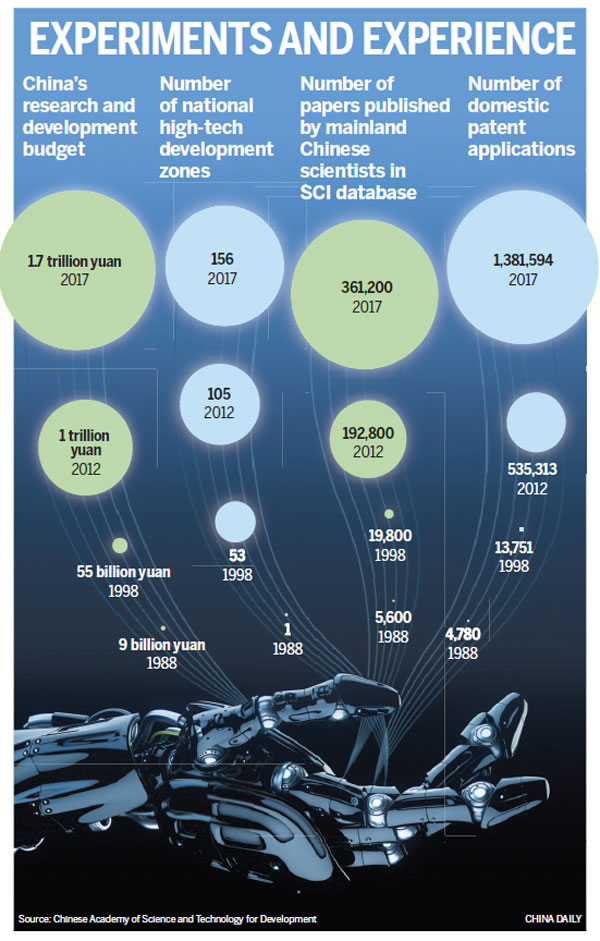 News
News 
 Contact Us
Contact Us
No. 18, Fuyuan Road, Tianjin Wuqing Development Area, China
Pushing the boundaries to aid the world

quantum physics to hybrid rice,Chinese scientists are helping to shape the future.Zhang Zhihao and Zhang Yangfei report.
Editor\'s note:This is the first in a series of stories reflecting China\'s achievements in fields such as science,law enforcement,education and transportation resulting from 40 years of the reform and opening-up policy.Other stories will follow in coming weeks.
Tu Youyou:Saving millions from malaria with an ancient remedy
Tu Youyou\'s resume may pale in comparison with those of other Nobel laureates,because she only holds a bachelor\'s degree,has no overseas research experience and is not a fellow of any Chinese scientific academies.
However,her discovery of artemisinin,the active compound that serves as the backbone for the most effective antimalarial treatment to date,has helped avert more than 6.2 million deaths globally between 2000 and 2015,according to the World Health Organization.By the end of 2016,artemisinin and its partner drugs were being used by 80 countries and regions.
In 2015,Tu won the Nobel Prize in Physiology or Medicine,becoming the first Chinese to win the award.In January last year,she became one of two recipients of the 2016 State Preeminent Science and Technology Award,China\'s highest scientific honor.
The 87-year-old from Ningbo,Zhejiang province,is now working on understanding and overcoming resistant to artemisinin in plasmodium(mosquito parasites that cause malaria).Her team is also investigating the use of the drug to cure illnesses such as cancer,lupus(an autoimmune disease)and leukemia.
"My greatest wish is that as our country reforms and opens up,our institutes will allow more capable young scientists to stand out and contribute to its development,"she said in a 2015 speech.
In 1967,malaria was ravaging the population of southern China,so the government formed Mission 523,a project to discover a cure for the illness.
As an expert in traditional Chinese medicine,Tu was appointed head of the mission in 1969,but her quest was daunting because more than 240,000 compounds had already been tested unsuccessfully across the world.
Tu decided to start from scratch by scouring medical literature from ancient China along with folk treatments,and consulting TCM practitioners.
After a few months she discovered that sweet wormwood had been used as malaria treatment in China since 400 AD.However,crude extracts of the plant could not reliably inhibit plasmodium growth,which meant the active ingredient had to be identified.
Over the next two years,Tu and her colleagues made 190 consecutive,but fruitless,attempts to raise the inhibition rate to 100 percent.By the time the right active ingredient,artemisinin,had been found and extracted,Tu was seriously ill with toxic hepatitis due to long exposure to poisonous solvents.
The drug showed promise during tests on mice and monkeys,but some researchers were concerned about its toxicity in humans.In response,Tu volunteered to be the first human recipient,saying,"I am the head of the research team-it is my responsibility."
In 1978,the appraisal committee for Mission 523 approved the use of artemisinin-based drugs to treat malaria.From the early 2000s,the World Health Organization gradually adopted the use of artemisinin-based combination drug therapies as first-line treatment for tackling malaria worldwide.
Zhao Zhongxian:Pushing physics with pots and passion
Zhao Zhongxian,winner of the 2016 State Preeminent Science and Technology Award,often said his true passion-the subject that has captivated him for more than 50 years-is pushing the limits of superconducting materials in physics.
Since the discovery of superconductivity in 1911,scientists around the world have competed to discover new superconductors-materials with no electric resistance if cooled to extremely low temperatures,typically a few dozen degrees above-273 C,known as absolute zero.
Superconductors can carry a far greater electrical current than typical conductive materials,and can also repulse external magnetic fields around their surface,leading to the creation of powerful electromagnets.
Notable applications of superconductors include Maglev trains,magnetic resonance imaging and the Large Hadron Collider,the world\'s largest and most powerful particle accelerator.
However,superconductors were impractical and uneconomical before the 1980s because expensive liquid helium was required to bring the temperature close to absolute zero.
In 1987,Zhao discovered a new copper-oxide-based superconductive material that could operate at around-180 C,significantly raising the practicality of superconductors because liquid nitrogen-cheaper and more freely available than liquid helium-can easily provide the critical temperature.
"When we made the early discoveries,our lab was dirt poor,"Zhao said."During the day,we did research with pots and stoves we made ourselves,and at night,we fought rats in our bedsheets.
"It\'s no joke to say that our research conditions have improved hundreds of times since the 1960s,"he said,adding that 40 years of reform and opening-up have made China more stable and richer,making it easier to conduct research.
"Young scientists today have solid knowledge,abundant budgets and advanced equipment,but there are also more distractions in the world."
He added that the secret behind his lifelong dedication is"making a living doing what you truly love".
"The greatest joy of being a scientist is that we are constantly overcoming obstacles and working towards a breakthrough every day.And when you finally make that breakthrough,you can see a new world like no other."
Yuan Longping:Achieving the dream of feeding the world
Members of the agricultural science community often humorously comment,"Two Pings fed the Chinese people",according to People\'s Daily.
The first"Ping"is Deng Xiaoping,the architect of China\'s reform and opening-up policy which greatly improved people\'s livelihoods,while the second is Yuan Longping,who created the world\'s first hybrid rice in 1974.
Yuan,who was born in Beijing but has lived mostly in Hunan province,has devoted his life to breaking yield records and safeguarding food security for the people of China and the world.
Hybrid rice is created by crossbreeding two genetically distinct rice"parents",whose"offspring"occasionally embody stronger characteristics-such as better resistance to disease and insects,and higher yields-than either parent,according to the International Rice Research Institute.
This makes hybrid rice fundamentally different from genetically engineered rice(also known as transgenic rice)because no foreign genes are introduced using genetic engineering.However,it is extremely difficult and time-consuming to produce hybrid rice with the right characteristics,the institute said.
"Among high-tech scientific research,hybrid rice is one of the fields in which China has consistently led the world for decades,"Yuan told Xinhua News Agency this year.On his 88th birthday in September,he said he still has three dreams to fulfill before he retires.
"The first is to create rice straws so big and yielding so many grains that people can take shade under the stems,"he said."The second is seeing hybrid rice planted across the globe to eliminate world hunger."
His third dream is to turn China\'s 100 million hectares of saline wasteland into a breadbasket.Yuan estimated if 10 percent of China\'s saline soil were to yield rice at around 4.5 metric tons per hectare,at least an extra 80 million people could be fed.
Despite the monumental task,Yuan\'s dreams are slowly becoming realities.
On Oct 29,Xiangliangyou 900,a super-hybrid rice strain developed by Yuan and his team,yielded about 18 tons per hectare,surpassing Yuan\'s world record of 17.25 tons per hectare set last year,according to Xinhua.
Yuan also made headlines this year by growing rice in the most unconventional places-China\'s saline soils and the deserts of Dubai in the United Arab Emirates.
In May,the fields in Dubai,which were irrigated with sea water,yielded more than 7.5 tons per hectare,making China the only country capable of growing rice in a tropical desert.
Next year,researchers and entrepreneurs from China and the UAE will launch a 100-hectare standard farm planted with desert rice,and help to accelerate the process of building a green,ecological Dubai in 2020,Xinhua said.
On Oct 10,Yuan\'s saline hybrid rice reached a yield of around 3.9 tons per hectare in his test fields in Qingdao,Shandong province,proving the hybrid\'s feasibility and potential.
Mass planting of hybrid rice was approved in 1996.In 2015,the Ministry of Agriculture estimated that approximately 50 percent of China\'s rice-growing land had been sown with the strains developed by Yuan.
Hybrid rice has also increased yields in key rice-producing countries including Indonesia,Vietnam,Myanmar,India,Brazil,the United States and the Philippines,the ministry added.
Pan Jianwei:Leading China into a quantum future
Imagine a future where the internet is hack-proof,where computers can calculate quicker than today\'s supercomputers,and secrets are kept safe using strange physical phenomena that even Albert Einstein didn\'t understand.
That is the future that quantum physicist Pan Jianwei-known in China as the"Father of Quantum"-hopes to achieve through his work in quantum physics and the study of subatomic particles,nature\'s smallest building blocks.
Known for his optimism,enthusiasm and vision,the 48-year-old physicist from Dongyang,Zhejiang province,is spearheading China\'s march toward a quantum future.
In 1996,when Pan was pursuing a doctorate in physics at the University of Vienna,Austria,under renowned quantum scientist Anton Zeilinger,his mentor asked him why he wanted to study quantum physics.Pan replied,"I want to build a world-class quantum physics lab like the one you have,but in China."
While studying in Austria,Pan helped write a paper,"Experimental Quantum Teleportation",that became one of the most influential for quantum communication technologies after it was published in the journal Nature in 1997,according to Science Citation Index(SCI),a global scientific literature database.
In Time Magazine,which listed Pan as one of this year\'s 100 most influential people,Zeilinger wrote:"I can\'t imagine the emergence of quantum technology without Jianwei Pan.He is the kind of person who rolls up his sleeves and gets to work.His long-term goal of a quantum internet has come a few leaps closer because of this."
The term"quantum internet"refers to a network of satellites and ground-based equipment capable of sharing quantum information across the globe.This method of communication is inherently secure because attempts to eavesdrop affect the quantum state and trigger alarms,making it useful in government,defense,finance and other fields where security is paramount.
In 2001,Pan returned to China and ignited under the country\'s pursuit of quantum technologies.In the presmartphone age,he began building the world\'s first quantum communications satellite,Micius.
In 2016,the launch of Micius cemented China\'s reputation as a world leader in the application of quantum technology.
The satellite pushed the boundaries even further last year by establishing a quantum link between particles more than 1,200 kilometers apart,smashing the previous world record of 144 km.It also teleported a photon,the fundamental particle of light,from Earth to space instantaneously for the first time.
"China is at least five years ahead of the rest of the world in terms of quantum communications,"Pan said."It has also made world-class achievements in quantum computing.I hope within my lifetime,I will see the birth of the quantum internet."
Source:ChinaDaily
Release Time:2018-11-21 13:07:58
